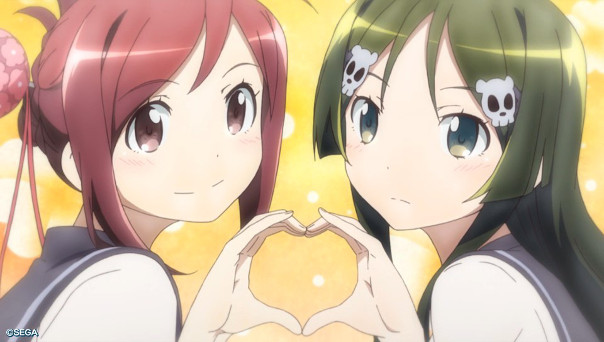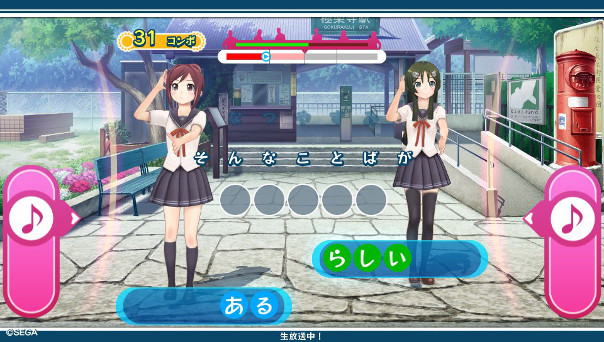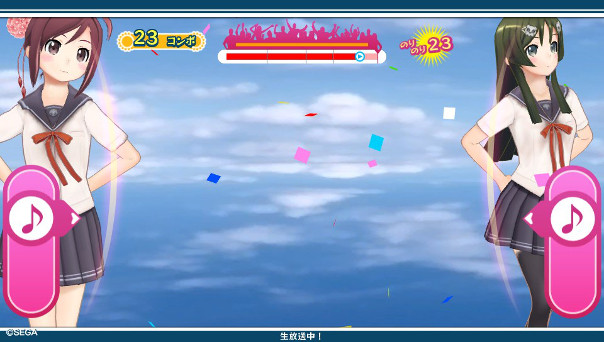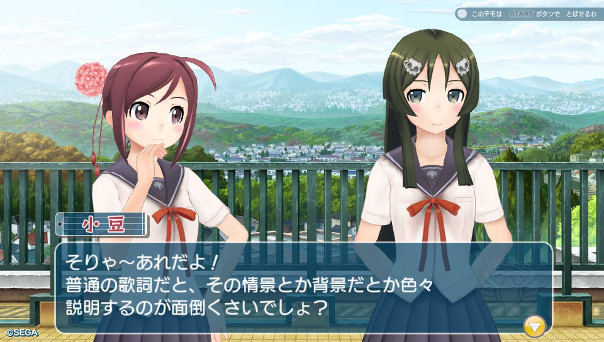Attack of the School Haiku Idols

Those of you who have been looking up the list of shows for the upcoming anime season have probably noticed the inclusion of Go! Go! 575, the TV show in which best friends Azuki and Matcha (who go together like… green tea and red-bean buns, I guess) decide to form a Haiku club at their school. And also sing and dance, because that’s what you do these days. The show is based around SEGAs Project 575, a media-mix project that is mostly spearheaded by the two game titles, the iOS Utayomi 575 and, probably more significantly, the upcoming Vita game Utakumi 575.
They released a trial version of Utakumi on PSN yesterday. I’ve heard (but haven’t bothered to verify) that they’re limiting it to 200,000 downloads for some reason I can’t quite fathom, though I’ve seen no particular indication that they’ve hit that limit yet (I’ve seen nothing through their Twitter, at least). You might want to grab it promptly if you have a Vita and are *cough*in Japan*cough*, though.
I have, of course, downloaded and played through it several times already.

The game part of the Utakumi equation is something of a weird hybrid of a puzzle and a rhythm-action game. Azuki and Matcha stand there at the back of the screen singing and dancing, whilst lyrics appear on the screen. Being fans of the haiku form means that, of course, all (or pretty much all, at least) of the song lyrics are in haiku format – the puzzle part of the game comes in the form of the fact that sometimes parts of the song will be blank. You’ll be presented with a bunch of text options (I’ve seen up to four word options for some selection points in the two songs in the demo), and you’ll have to select, under narrow time-limit, what goes into the blank spaces. Most frequently you’ll be presented with exactly the right number of items to go into the spaces, and you’ll simply be tasked with coming up with the right order. Sometimes there’ll be more options than required, with or without a clue as to what you should be selection. Sometimes there will even be an alternate, but still syntactically valid, option that will nab you an arrange bonus at the end of the song.
Not that getting the lyrical arrangement incorrect is particularly the end of the world (to the relief of the moon-rune challenged, like myself) – the song will still continue, and it doesn’t actually break your combo bonus. Infact, it doesn’t even break the song – all the vocals in the game are powered with Vocaloid(tm) technology, meaning it automatically tunes whichever lyric arrangement selection you make to the tune of the music without any discernible break or difference. It’s kind of neat that way.
The rhythm-action part of the game which goes around that is pretty straight-forward – there’s a bar down each side of the screen, down which either musical notes or syllable symbols will scroll down, and you’ll need to hit the relevant (on-touch-screen) button at the right time. Like most of these things, there’s also hold-notes (where you need to keep the button pressed down for the duration of a sustained notes, represented by a bar). It’s hardly Shiny Festa/TV in complexity or anything – at least as far as the trial goes, they don’t go bonkers with the number of notes thrown at you – though juggled with having to do pick out the haiku lyrics to fill in the blanks, it’s easy to over-run on thinking time and end up making a mess out of the rhythm sections as a result.
(As an aside, Iori’s ShinyTV pack this week as pretty good, though the S4/Master Visionary challenge took me many more attempts than it probably should have. It wasn’t, at least, Kaza-bloody-hana, though!)
I will say that I’m not keen on the addition of the back-touch presses during rhythm sections – that is, some of the music notes are blue, rather than red, and require the tapping of the rear touch pad on the relevant side of the system. I just find those awkward to perform.

The presentation during the songs is pretty simple – don’t go into it expecting Shiny or Project Diva levels of dynamic presentation or anything. Infact, for most of the songs, you are looking at a single fixed camera angle of a static, hand-drawn background image, with the two characters rendered in 3D over that. I’m kind of curious about the development choice here – on the one hand, it does mean that you have what are, for the Vita hardware, rather well realised, well articulated character models. Whether this is down to them being able to devote so much of the machines horsepower to characters alone, or simply good art direction, isn’t entirely clear – I wonder how much of the games visual direction is forced due to the vocaloid technology required to get the songs to work being a hog on CPU cycles and, maybe more importantly, system memory.
That said, in the back quarter of the songs, the game does enter Nori-Nori Time, where the background is rendered rather more abstract, and the camera is unleashed, free to flail around in a rather more interesting, dynamic fashion.
As far as the music goes, there’s only two songs in here, so it’s a little hard to make any real judgements. The music is catchy enough, but the vocal performances are a little monotone and droney-sounding at times – this isn’t a slam against Vocaloid-produced music (I’ve listened to and enjoyed plenty of that stuff), but I do wonder if the slightly dynamic nature of the lyrics and the haiku format has robbed the composers of a certain amount of fidelity and nuance in the way they tune their vocals.

The rest of the games presentation seems fine. The demo has the same anime PV you’ve probably seen at least clips of elsewhere as the attract mode. The rest of the narrative is presented in a fairly standard visual-novel style – they’re using the 3D models, rather than 2D portraits, in these sequences, and they do anime, but it’s basically just switching between a different pose between each of their lines of dialogue, and the motion comes across as a little stiff at times. I’m not entirely sure if it’s just texture-swapping or not, but mouth movements are sudden jumps to the mouth shapes, rather than smoothly animated lip-flaps as in iM@S, but I guess that just gives it slightly more of an anime feel.
I’m probably underselling that a bit, though – there’s some other animation going on in the narrative sequences occasionally, and the second of the two narrative sequences in the demo is done predominately with the two characters faces reflected on a monitor screen as they read e-mail. That was neater than I’d expected. I’m kind of curious to see how much of this kind of thing (or just how much narrative as a whole) is going to be presented in the final game.
To draw a conclusion, I was actually somewhat surprised by Utakomi 575 – as much as I probably (as always) come across as negative here, I actually quite like the game. The trial version of it has actually sold me on it, and I’ll probably end up picking it up when it’s released at the back-end of next month. If nothing else, it’ll kill some time until the Cartoon Idol Fan Murder Month of May, when we see the new iM@S game, the three Love Live Vita games, and that subtitled re-release of the Macross Frontier movies released in Japan within the span of just two weeks.
My wallet weeps already.
